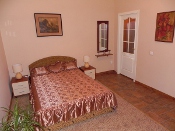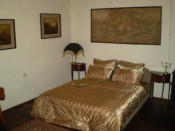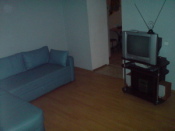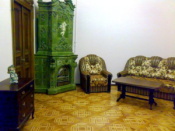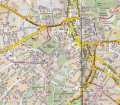The date of foundation of Lvov is consider 1256 year. Exactly this year about Lvov find the first mention in in the Galicko-volynskoy chronicle in which our city is mentioned in connection with a fire in Hill ‚Äě and flame was such, that from all of earth a glow was visible, also and from Lvov on Belz'kikh the fields, because strong was flame of fire" (In 2000, during build robot in a court the Lvov house, tailings of fragments of old structures which can be probably dated on 200 years before the resulted date were dug out!) Mention is on tragic time after the –ú–ĺ–Ĺ–≥–ĺ–Ľ–ĺ-—ā–į—ā–į—Ä—Ā–ļ–ĺ–≥–ĺ invasion, when prominent figure of Ancient Russia, prince of the Galicko-volynskogo state, Danilo Galichina, which in 1253, taking a crown over Dad Roman Innokentiya III, became the first Galicko-volynskim king.Strengthening the scopes of principality, king Danilo Galichina built a city(according to legend in 1241–≥–ĺ–ī—É) and named it after the son Leo. Built him in due form that time.
 |  |
A city consisted of three parts - fixed city, fence surrounding a village and suburb. Strengthening was disposed in the district of the present Prince mountain. A city was dissociated from the High lock a deep ditch and fixed high billows and paling so that reliably to ward off an enemy. A suburb was occupied by a right ripa Poltva and was located –Ņ–ĺ–Ľ—É–ļ–ĺ–Ľ—Ć—Ü–ĺ–ľ on the slopes of the Prince mountain. Separately, on the top of steep mountain, the monastery of saint was disposed George. A trade-route lay through a city, by numerous churches and churches. They were wooden, therefore to our days not saved. Stone temples were built in them place: church of —Ā–≤.Ïðàñêîâüè, —Ā–≤.Îíóôðèÿ, —Ā–≤.Íèêîëàÿ, church of Ivan Krestitelya. In 1349 Polish king Cassimere the III Great takes Lvov and after seven years in 1356 grants a city the Magdeburgskoe right.In a 1370-1387–≥–ĺ–ī—É city is under Hungarian dominion.In 1387 queen Yadviga returns Lvov, to Poland. In the middle of a 14 age by Germans a new city was built on territory of quadrangular form, with a central rectangular area. Streets were lines and intersected at right angles. All of streets were thickly populated, buildings were built mainly in a gothic. Gothic temples were also built in wood, therefore after a fire in 1517 were destroyed. From those times saved only –≥—Ä–Ķ–ļ–ĺ-–ļ–į—ā–ĺ–Ľ–ł—á–Ķ—Ā–ļ–į—Ź –ļ–į—ā–Ķ–ī—Ä–į. A city was protected by the High lock, built in a 14 age on a mountain, higher, than the Prince mountain. Due to an advantageous location on crossing of point-of-sale routes from ports of the Black sea, Kiev, East and Western Europe, Byzantium and ports of the Baltic sea the representatives of the most different nationalities took part in building of city, that evidently from the names of streets of his historical center: Armenian, Russian, Old-Jewish, Serbian, and other Lvov in the pore of dark ages tirelessly increased and was built on. At the beginning of the XV item about 10 thousand of habitants was counted in him, and in the first half of XV–Ü–Ü of item he becomes the most city of Ukraine with a population 25-30 thousands of persons. Basis of economic development were trade and handicraft. At the Lvov market it is possible it was to see silks, carpets and spiciness from orients, fur from Russia, guilt and cattle from Hungary and Valakhii, commodities from other –∑–į–Ņ–į–ī–Ĺ–ĺ–Ķ–≤—Ä–ĺ–Ņ–Ķ–Ļ—Ā–ļ–ł—Ö countries. Far there were the known wares of local artisans, in XV–Ü–Ü of item incorporated in 30 workshops In the period of 16-17 ages a city was built on actively. Churches were built, churches mainly in style of renaissance. The decline of city, conditioned wars and internal political situation, began at the end of a 17 age. The period of baroque was begun with the construction of church and monastery of Jesuits 1610-1740 But to our times not a single reminder was saved in a that kind, in what it was at that time. After it all of strengthening were taken in a 18 age, a city got up on the new way of the development. Old houses reformed, the new was built, a lot of temples was passed in the public use. Except for it, a city was also and by a fortress, which removed the attacks of hostile troops (more frequent than all turk and Tatars) not once, outlived the siege of Bogdana Khmel'nickogo troops, bought off turk in 1672, which then were the allies of Doroshenko and there was obtained the Swedish troops. For the concordance of general actions against Charles X–Ü–Ü in 1707 a tsar Peter arrived to Lvov ². In 1704 after the attack of Swedes under leadership king Charles XII L'vov began to fall into a decay. At the first section of Speech of Pospolitoy (1772 year) a city, being component part of Galicii, stepped back to Austria, was whereupon renamed in Lemberg and became the capital of province, gradually growing into an industrial, point-of-sale and cultural center. In 1867 Lvov entered in the complement of –ź–≤—Ā—ā—Ä–ĺ-–í–Ķ–Ĺ–≥—Ä–ł–ł. In the First world war-time, from September 1914 for June of 1915th, was busy at the Russian troops. After disintegration of –ź–≤—Ā—ā—Ä–ĺ-–í–Ķ–Ĺ–≥—Ä–ł–ł power in Lvov took the ¬ęNational soviet¬Ľ, proclaiming education in Galicii of the ¬ęZapadno-ukrainskoy folk republic¬Ľ. And from 1919 on 1939th, after the capture of city by Poland, was the administrative center of the Lvov province. In 1939 after tacking to the USSR of Western Ukraine of Lions became a regional center UKRAINE, and after 1991 are the states Ukraine.






